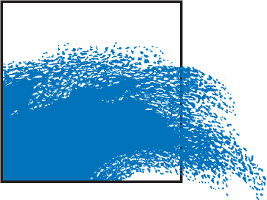BA Color codes and oil volume estimation
The Bonn Agreement Oil Appearance Code or BAOAC is a method for estimating oil volumes at sea.
The BAOAC was developed on the basis of a series of scientific experiments and studies in the framework of the Bonn Agreement. The method was developed specifically for surveillance from the air and for use by operators who are trained to recognise and evaluate oil pollution at sea from an aircraft or helicopter. Based on a visual observation of the oil pollution, the method can only be used during the day and in periods of good visibility. Volume estimates of an oil slick at sea are not possible from a floating platform (or from the quayside in a harbour). However, floating units can make rough estimates of certain steps in the BAOAC, and evaluate in broad terms the severity of a slick which is visible from the water. Therefore some elements of the BAOAC method can be usefully applied from a floating platform (where possible), although the uncertainties necessarily involved in such a case should always be borne in mind.
The steps
When estimating oil volume on the basis of the BAOAC method applied from the air a number of steps must be followed.
-
Determination of the polluted water surface area
The polluted water surface area can be estimated from the air either by means of a visual estimation or with the help of sensors on a specially equipped surveillance aircraft. This involves two steps:
-
When doing a visual observation: first determine the length and breadth of the rectangle in which the oil slick is contained, then estimate the oil coverage inside that rectangle, taking account of the level of fragmentation and spread of the oil on the water.
-
When using sensors: first draw a polygon around the SLAR detected slick, get the onboard computer to calculate the surface area of the polygon, then estimate the oil coverage inside the polygon.
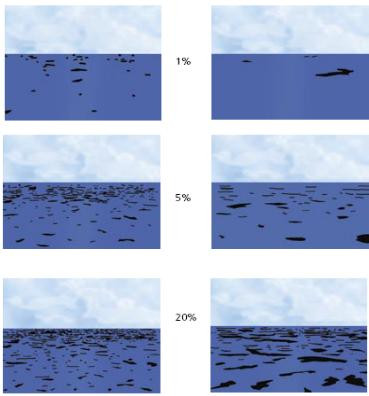
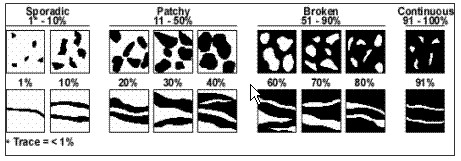
Reference plates for ‘oil coverage’
(Source: Cadre, 2006. ‘Aerial Observation of Oil Pollution At Sea – Operational Guide’; EC, 1996. ‘POLSCALE’). -
-
Distinguishing between thinner and thicker areas of an oil slick
From the air a visual observer will then further subdivide the polluted water surface area into percentage estimated zones where a given oil appearance is observable. The BAOAC studies have shown that a mineral oil slick can present 5 different oil appearances that are dependent on the relative thickness of an oil layer. The 'colour' of an oil film depends on the way in which incoming rays of light of different wavelengths are reflected from the oil surface, pass through the oil, are reflected by the water surface beneath the oil, and/or are absorbed by the oil. The oil 'colour' observed is the result of a combination of these factors. As far as the thicker oil layers are concerned, the colour is also in part dependent upon the type of oil that is discharged.
The 5 levels of oil appearance are as follows:
-
Code 1. ‘Sheen’ for all oil layers of 0.04-0.3 µm thickness, the sunlight being better reflected by the oil than by the surrounding water.
-
Code 2. ‘Rainbow’ for slightly thicker oil layers of 0.3-5 µm thickness: includes a whole series of 'rainbow' colours (yellow, pink, purple, green, blue, red, copper, orange, etc.) caused by constructive and destructive interferences, peculiar to the layer thickness, between different wavelengths of daylight.
-
Code 3. ‘Metallic’ for oil layers of 5-50 µm thickness: typical for this appearance is the matt metallic lustre. The colour of this metallic lustre is largely determined by the colour of the underlying water because the oil layer is not thick enough to block the light being reflected by the water surface, and also in part by the 'colour' of the sky (e.g. blue sky or grey clouds) produced by the light reflection.
-
Code 4. ‘Discontinuous true oil colour’ for thicker oil layers of 50-200 µm thickness. For oil films from 50 µm thickness the light is reflected by the oil rather than the underlying sea surface, rendering visible the true oil colour of the discharged oil. The true oil colour only gradually becomes the dominant colour with brown oil appearing brown and black oil appearing black. Code 4 is nevertheless a transitional code as the thinner layers will alternate with thicker layers due to the effect of the waves. This code is also often described as "true oil colour against a background of metallic."
-
Code 5. ‘Continuous true oil colour’ for the thickest oil layers from 200 µm thick: The true oil colour of the discharged oil type is here dominant and (as opposed to Code 4) is clearly visible.
Codes 4 and 5 in particular (with the true oil colours) contain considerable quantities of oil over a small surface area and in most cases are therefore regarded as slicks that can be combated at sea. The other codes for thinner oil layers that often cover the largest areas of an oil slick contain too little oil for combating to be a reasonable prospect, even if dispersants are used.
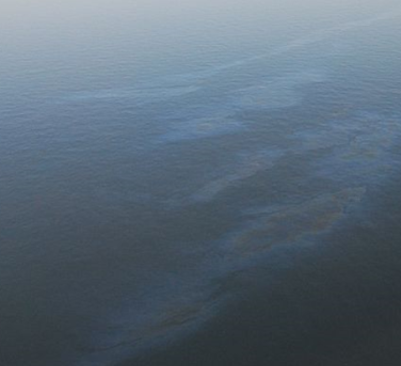
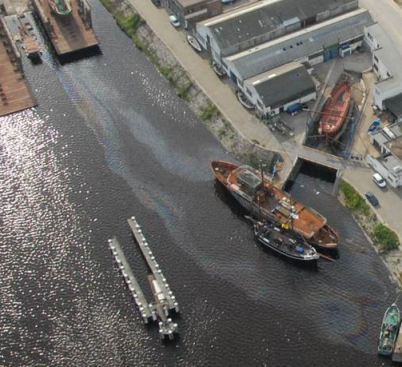
Thin oil slicks at sea (left) and in a harbour (right) consisting of Sheen and Rainbow appearances (Codes 1 and 2). 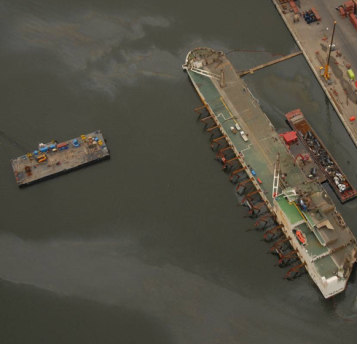
Oil slick consisting principally of Code 3 – Metallic, with a regular metallic lustre that resembles the colour of the underlying sea surface (other visible codes on the photo are Codes 1 and 2 – Sheen and Rainbow). 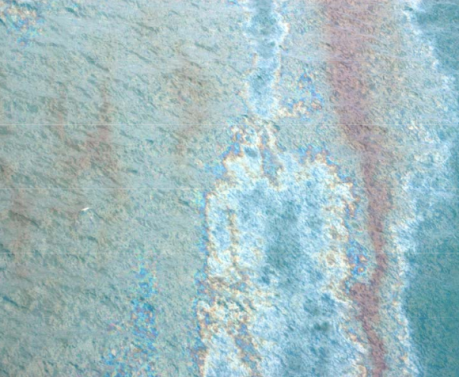
Oil slick consisting principally of Code 4 – Discontinuous true oil colour, a transitional code consisting of true oil colours against a 'Metallic' background (Sheen and Rainbow areas are also visible on the photo). (Photo: BAOAC Atlas, Bonn Agreement). 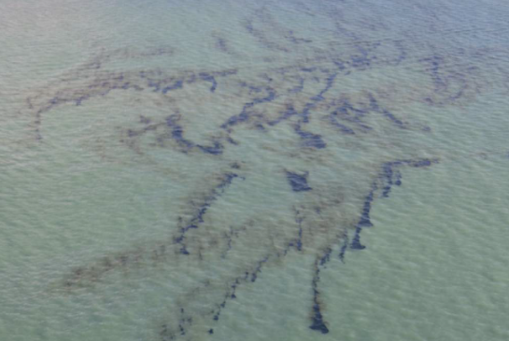
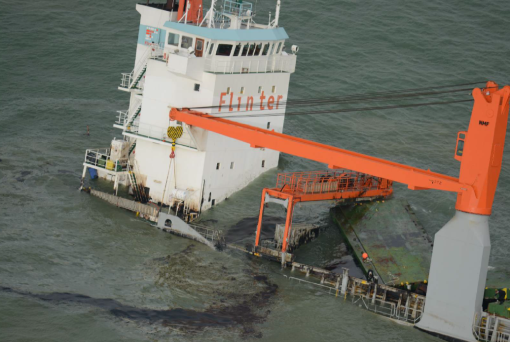
Oil slick consisting of Code 5 – Continuous true oil colour in which the true oil colour is clearly defined and visible. -
-
Oil volume estimation of an oil slick
The minimum and maximum volumes are deduced from, on one hand, the minimum layer thickness in which a colouring is visible and the maximum layer thickness in which the colouring moves to a "higher" code. The oil volume is then calculated using a simple mathematical formula in which the polluted surface area per code is multiplied by the percentage of that code present in a slick and the minimum and maximum layer thicknesses. The minimum volume estimation is typically used in criminal cases (to give the volumes established as a minimum) while the maximum volume estimation tends to be used in cases of accidental sea pollution (typical worst case evaluation in crisis management).
COLOUR CODE LAYER THICKNESS INTERVAL
(µm)MINIMUM QUANTITY
(m3/km2)MAXIMUM QUANTITY
(m3/km2)1 Sheen 0.04 - 0.30 0.04 0.30 2 Rainbow 0.3 - 5.0 0.30 5.00 3 Metallic 5 - 50 5.0 50.00 4 Discontinuous true colour 50 - 200 50.00 200.00 5 Continuous true colour >200 200.00 >200.00 BAOAC – oil colouring, layer thickness (in µm) and related min.-max. volume intervals (in m3/km2) (Source: Bonn Agreement Aerial Operations Handbook, 2009).
BAOAC method on board vessels
The BAOAC was specially developed in the framework of the Bonn Agreement as a means of estimating oil volumes at sea from the air. However, oil volume estimates on the basis of the BAOAC are not possible from shipping vessels, because ships lack the necessary helicopter view for appraising the slick. Some elements of this method can nevertheless be used from a floating platform.
-
The observation of different colour appearances within an oil slick and the making of a rough estimate of the severity of a discharge or pollution at sea by differentiating between the thicker and the thinner oil layers (in principle, those areas where the pollution can be fought and those where it cannot).
-
A rough estimate of the extent of an oil slick. To some degree this is possible from a ship, but the margin of error will be high, especially in the case of larger slicks that cannot be viewed in their entirety from a ship.
-
Distinguishing and describing in more detail the thicker elements of a slick. This is useful for estimating the area of the slick in which the pollution can be fought.
Conclusion
If an emergency arises at sea, a vessel is often the first to arrive at the scene. The aforementioned rough descriptions of an oil slick that can sometimes be made from a vessel are always helpful in gaining an initial impression of the seriousness of the emergency at sea and the degree to which the slick can be fought. But monitoring of an oil pollution incident from the air and air accompaniment for the oil fighting units at sea remain essential.

